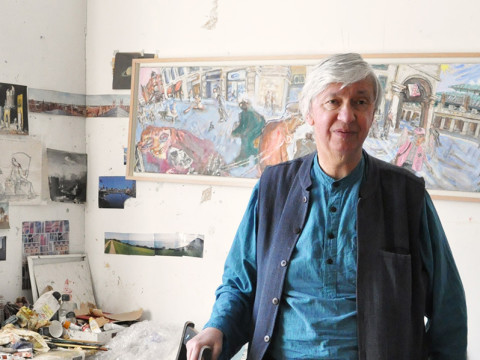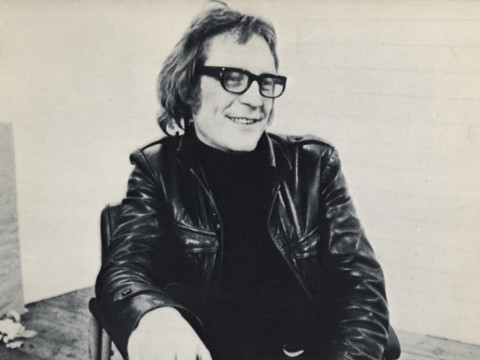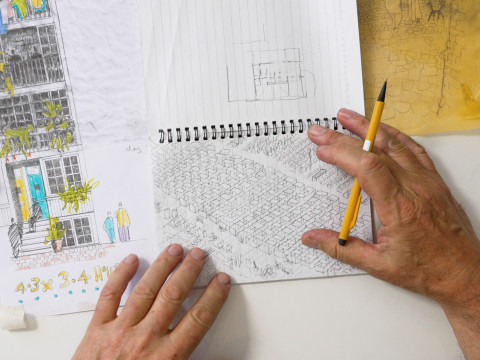
A tribute to Zaha Hadid RA: 1950–2016
By RA Architecture
Published on 30 March 2016
One of the world's greatest architects, Zaha Hadid inspired a generation. Following the sad news of her death, the RA's Head of Architecture and two fellow architects reflect on a visionary career.
Zaha Hadid RA sadly died in Miami following a heart attack on Thursday 31 March, aged 65. Announcing the news, the President of the Royal Academy, Christopher Le Brun, said: "We are shocked and saddened by the news of the passing of Dame Zaha Hadid RA. She was a visionary architect who has inspired a generation and this is a great loss for the world of architecture." Here, Kate Goodwin, Alan Stanton RA and Peter Cook RA pay tribute.
Kate Goodwin, RA Head of Architecture
The news of Zaha Hadid RA’s sudden death in Miami has sent ripples across the world. Her influence and renown stretched far beyond the architectural community, with her buildings – perhaps most famously, London's Olympic Aquatic Centre – capturing popular imagination. This Iraq-born architect inspired first with her paintings and drawings, and when she was finally given the opportunity to build she produced work which was truly visionary.
Her architecture is keenly intellectual and equally emotionally and creatively charged. Elected a Royal Academician in 2005, she is pioneering figure; the only woman to receive the Pritzker Prize (2004) and the RIBA Gold Medal this year, again the first time to a woman in her own right. As fellow Academician and long-time friend Peter Cook said in his Gold Medal citation of Zaha, she was “larger than life, bold as brass and certainly on the case. Our Heroine.”
She inspired first with her paintings and drawings, and when she was finally given the opportunity to build she produced work which was truly visionary.
Kate Goodwin, Head of Architecture
Alan Stanton RA, architect and Chair of the Architecture Committee
Zaha Hadid was a force of nature. Her creative power and strong personality pushed architecture into a new territory that, not only produced seminal buildings, but raised public awareness and encouraged debate about the very nature of architecture.
Although Zaha had the courage to work "on the edge" of mainstream architecture (which she freely admitted was the best place to be) over recent years her practice received an increasing number of accolades and important commissions and she was building more and more. The news of her death will have come as a profound shock to architects everywhere and her presence within the world of architecture will be hugely missed.
Zaha Hadid was a force of nature.
Alan Stanton RA
Peter Cook RA, architect
Peter Cook RA wrote the following tribute in February, when Hadid was presented with the RIBA’s 2016 Royal Gold Medal.
In our current culture of ticking every box, surely Zaha Hadid succeeds, since (to quote the Royal Gold Medal criteria) she is someone “who has made a significant contribution to the theory or practice of architecture… for a substantial body of work rather than for work which is currently fashionable.” Indeed her work, though full of form, style and unstoppable mannerism, possesses a quality that some of us might refer to as an impeccable "eye": which we would claim is a fundamental in the consideration of special architecture and is rarely satisfied by mere "fashion".
And surely her work is special. For three decades now, she has ventured where few would dare: if Paul Klee took a line for a walk, then Zaha took the surfaces that were driven by that line out for a virtual dance and then deftly folded them over and then took them out for a journey into space. In her earlier, "spiky" period there was already a sense of vigour that she shared with her admired Russian Suprematists and Constructivists – attempting with them to capture that elusive dynamic of movement at the end of the machine age.
Necessarily having to disperse effort through a studio production, rather than being a lone artist, she cottoned–on to the potential of the computer to turn space upon itself. Indeed there is an Urban Myth that suggests that the very early Apple Mac "boxes" were still crude enough to plot the mathematically unlikely – and so Zaha with her mathematics background seized upon this and made those flying machine projections of the Hong Kong Peak project and the like. Meanwhile, with paintings and special small drawings Zaha continued to lead from the front. She has also been smart enough to pull in some formidable computational talent without being phased by its ways.
Thus the evolution of the "flowing" rather than spikey architecture crept up upon us in stages, as did the scale of her commissions, but in most cases, they remained clear in identity and control. When you entered the Fire Station at Vitra, you were conscious of being inside one of those early drawings and yes, it could be done. Yet at perhaps its highest, those of us lucky enough to see the Heydar Aliyev Center in Baku in the flesh, can surely never have been in such a dream-like space, with its totality, its enormous internal ramp and dart-like lights seeming to have come from a vocabulary that lies so far beyond the normal architecture that we assess or rationalise.
Zaha: larger than life, bold as brass and certainly on the case.
Peter Cook RA
So we are presenting her with this Medal as a British Institution: and as a Dame Commander of the Order of the British Empire: thus she might seem to be a member of our British Establishment. Yet in reality, many of our chattering classes and not a few fellow architects have treated her with characteristic faint praise, and when she heroically won the Cardiff Opera House competition, blocking the scheme. Or when we awarded her the RIBA Stirling Prize for the school in South London – her second win in a row – we, the jury, were loudly derided by a number of distinguished architects. Of course, in our culture of circumspection and modesty her work is certainly not modest, and she herself is the opposite of modest. Indeed her vociferous criticism of poor work or stupidity recalls the line-side comments of the tennis player John McEnroe. Yet this is surely characteristic of the seriousness with which she takes the whole business: sloppiness and waywardness pain her and she cannot play the comfy British game of platitudinous waffle that is the preferred cushion adopted by many people of achievement or power. Her methods and perhaps much of her psychology remain Mesopotamian and not a little scary: but certainly clear.
As a result, it is perhaps a little lonely there up at the top, surrounded now by some very considerable talent in the office, but feared somewhat and distanced from the young. Yet in private Zaha is gossipy and amusing, genuinely interested in the work of talented colleagues who do very different architecture such as Steven Holl, and she was the first to bring to London talent such as Lebbeus Woods or Stanley Saiotowitz. She is exceptionally loyal to her old friends: many of whom came from the Alvin Boyarsky period of the Architectural Association: which seems to remain as her comfort zone and golden period of friendship. Encouraged and promoted at an early age by Boyarsky, she has rewarded the AA with an unremitting loyalty and fondness for it.
The history of the Gold Medal must surely include many major figures who commanded a big ship and one ponders upon the operation involved that gets such strong concepts as the MAXXI in Rome – in which the power of organization is so clear – or the Bergisel Ski Jump in Innsbruck where dynamic is at last captured – or the Aquatics Centre for the London Olympics where the lines diving boards were as fluid as the motion of the divers – made into reality. And she has done it time and time again in Vienna, Marseilles, Beijing and Guangzhou. Never has she been so prolific, so consistent. We realize that Kenzo Tange and Frank Lloyd Wright could not have drawn every line or checked every joint, yet Zaha shares with them the precious role of towering, distinctive and relentless influence upon all around her that sets the results apart from the norm. Such self-confidence is easily accepted in film-makers and football managers, but causes some architects to feel uncomfortable, maybe they’re secretly jealous of her unquestionable talent. Let’s face it, we might have awarded the medal to a worthy, comfortable character. We didn’t, we awarded it to Zaha: larger than life, bold as brass and certainly on the case.
Our Heroine.
How lucky we are to have her in London.
Peter Cook RA, February 2016
Gallery
Related articles

In memoriam: Norman Ackroyd RA
20 September 2024

In memoriam: Timothy Hyman RA
12 September 2024

In memoriam: Mick Moon RA
1 May 2024

Crunch: inside the first Architecture Window display
14 February 2024





